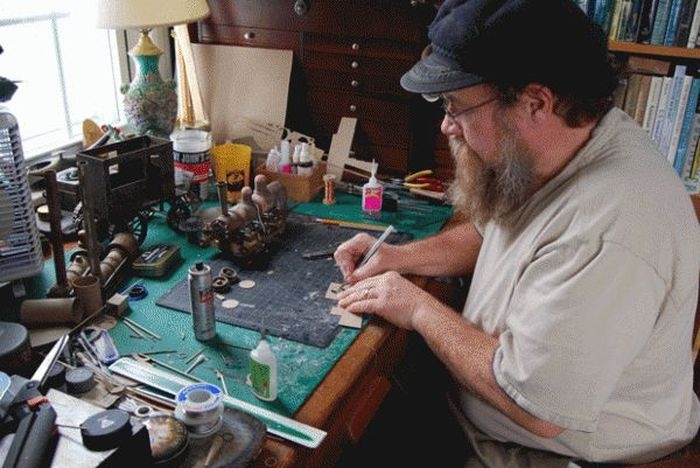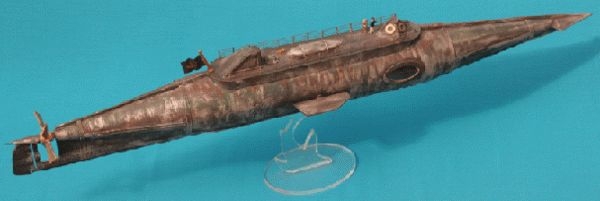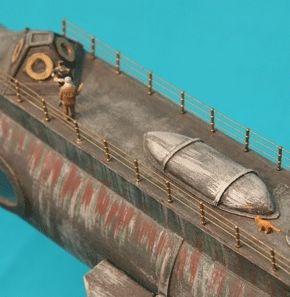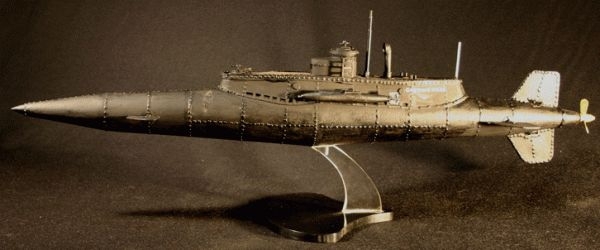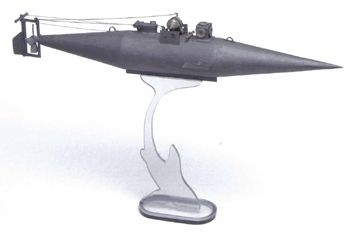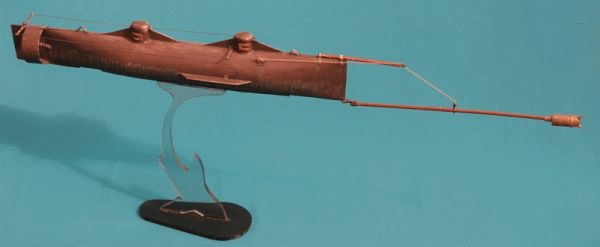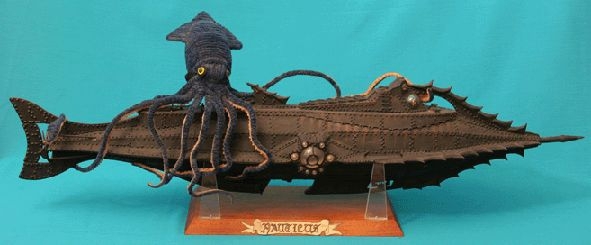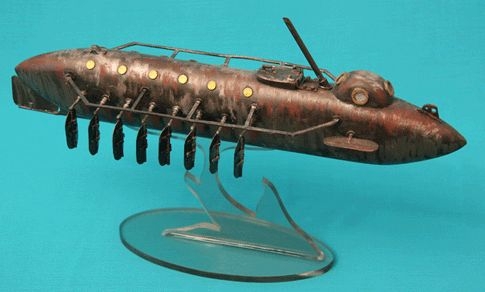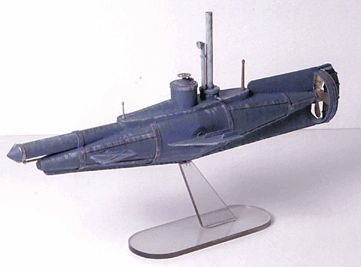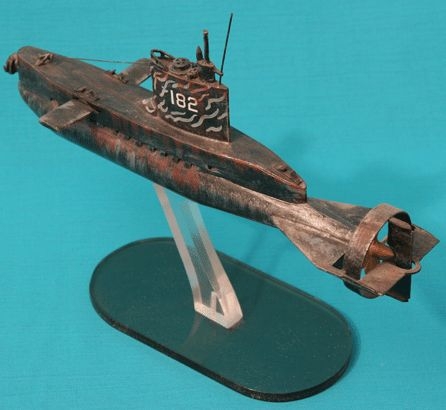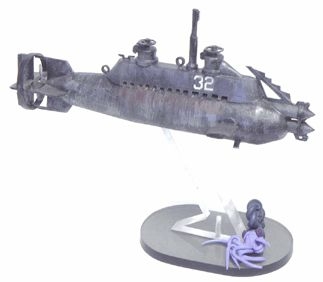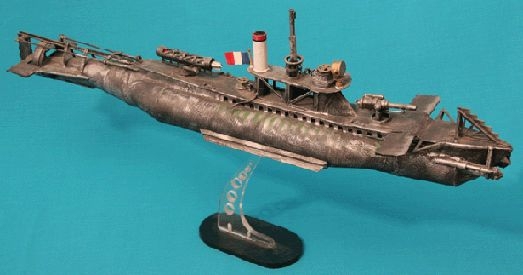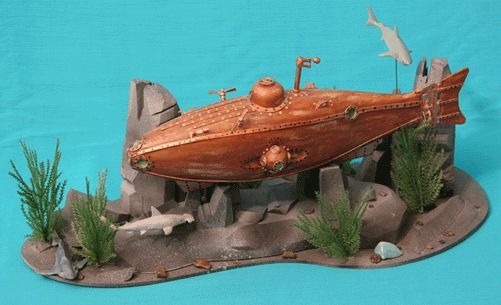629
13
There is an Internet site of creations by William Wardrop, it is called Stream Noir.
William makes paper models of submarines.
William makes paper models of submarines.
After decades of extensive research in history, military concept vehicles and classical literature, he has applied his expertise in model making to create unique three-dimensional examples of the many innovative and eccentric vehicle types of the 18th, 19th and early 20th century. Each vehicle is hand-crafted from William's own cardboard modeling technique.
This exhibit is a showcase of how vehicles from the Victorian Era drew upon both steam engine technology and contemporary Science Fiction sources to create the engineering marvels that have changed civilization and moved us into the modern era.
This exhibit is a showcase of how vehicles from the Victorian Era drew upon both steam engine technology and contemporary Science Fiction sources to create the engineering marvels that have changed civilization and moved us into the modern era.
The Jules Verne Nautilus
This model was designed from Jules Verne's descriptions and the original illustrations in his 1870's novel "Twenty Thousand Leagues Under the Sea". Although this craft looks less elegant than the Nautilus that Hollywood came up with, its design is in keeping with the first real submarines.
Here in this detail image, Professor Aronnax can be seen arguing with Captain Nemo over the fate of humanity.
This model was designed from Jules Verne's descriptions and the original illustrations in his 1870's novel "Twenty Thousand Leagues Under the Sea". Although this craft looks less elegant than the Nautilus that Hollywood came up with, its design is in keeping with the first real submarines.
Here in this detail image, Professor Aronnax can be seen arguing with Captain Nemo over the fate of humanity.
Gustave Zede'
The Gustave Zede was an important step forward in French submarine design however it wasn't a very successful one. She carried two torpedos in Drzewecki's drop collars which left them exposed to damage at dock side. It was also bad at maintaining a constant depth and eventually required three sets of hydroplanes to aid this design flaw. The Gustave Zede was 159 ft. long, 10 ft. in diameter and was powered by a 208 ehp motor. Still, I like her lines and the rivet constrution.
The Gustave Zede was an important step forward in French submarine design however it wasn't a very successful one. She carried two torpedos in Drzewecki's drop collars which left them exposed to damage at dock side. It was also bad at maintaining a constant depth and eventually required three sets of hydroplanes to aid this design flaw. The Gustave Zede was 159 ft. long, 10 ft. in diameter and was powered by a 208 ehp motor. Still, I like her lines and the rivet constrution.
The Pioneer
Built in Mobile Bay, by C.L.Hunley prior to the construction of the CSS Hunley, this craft was a prototype and never used. Its armament was a mine that was released and dragged behind the submarine on a cable until it found its target, where it would explode on impact. The main problem with this delivery system being that the cable could foul the propeller in which case a side-current could cause the bomb to impact the side of the submarine.
It was captured by the Union Army in 1863 and displayed in the Washington Navy yard until sold for scrap in 1867.
Built in Mobile Bay, by C.L.Hunley prior to the construction of the CSS Hunley, this craft was a prototype and never used. Its armament was a mine that was released and dragged behind the submarine on a cable until it found its target, where it would explode on impact. The main problem with this delivery system being that the cable could foul the propeller in which case a side-current could cause the bomb to impact the side of the submarine.
It was captured by the Union Army in 1863 and displayed in the Washington Navy yard until sold for scrap in 1867.
The American Diver
Built by C.L. Hunley after the Pioneer. The American Diver or Pioneer II as it is sometimes called, sank in Mobile Bay while being towed out to begin an attack on the Union fleet. Having only a three man crew it was woefully underpowered and not able to fight the incoming tide. A description of this submarine appeared in the news papers of France, Jules Verne possibly saw this description and incorporated many of the American Diver's unique attributes on the Nautilus, such as the dual conning towers.
Built by C.L. Hunley after the Pioneer. The American Diver or Pioneer II as it is sometimes called, sank in Mobile Bay while being towed out to begin an attack on the Union fleet. Having only a three man crew it was woefully underpowered and not able to fight the incoming tide. A description of this submarine appeared in the news papers of France, Jules Verne possibly saw this description and incorporated many of the American Diver's unique attributes on the Nautilus, such as the dual conning towers.
The Harper Goff Nautilus
Designed for Disney's "20,000 Leagues Under the Sea", the original model was created by Harper Goff to have more Victorian styling as well as elements making it more "seamonster like" in the water. Although hydrodynamic tests proved it to be sound, a full size working model has never been created. But I have been informed that a 1/2 size one has been created for the Prince of Bahrain. The giant squid attacking this Nautilus model is over three-feet long and was sculpted completely out of pipe cleaners by Laura Butler.
Designed for Disney's "20,000 Leagues Under the Sea", the original model was created by Harper Goff to have more Victorian styling as well as elements making it more "seamonster like" in the water. Although hydrodynamic tests proved it to be sound, a full size working model has never been created. But I have been informed that a 1/2 size one has been created for the Prince of Bahrain. The giant squid attacking this Nautilus model is over three-feet long and was sculpted completely out of pipe cleaners by Laura Butler.
The Alligator (Naval Institute Press Version)
This is a prime example of why you should always find as many references as you can before jumping in and building a model. The Alligator shown here is how the book “U.S. Submarines Through 1945” from the Naval Institute Press says it looked. I said, “Cool!” and went to work on the job. It took 26 hours to build and paint. I was happy with how it came out and chalked up one more historic submarine for my collection. However, two days after I put it up on my display shelf, I read on a news site that Brutus de Villeroi's original plans had been found in Paris, France. I took one look and saw that my model looked nothing like the original blueprints. It turns out that the N.I.P’s diagrams are conjecture and were never verified! I am now working on a more accurate model and history of this wonderful and inventive man-powered sub.
This is a prime example of why you should always find as many references as you can before jumping in and building a model. The Alligator shown here is how the book “U.S. Submarines Through 1945” from the Naval Institute Press says it looked. I said, “Cool!” and went to work on the job. It took 26 hours to build and paint. I was happy with how it came out and chalked up one more historic submarine for my collection. However, two days after I put it up on my display shelf, I read on a news site that Brutus de Villeroi's original plans had been found in Paris, France. I took one look and saw that my model looked nothing like the original blueprints. It turns out that the N.I.P’s diagrams are conjecture and were never verified! I am now working on a more accurate model and history of this wonderful and inventive man-powered sub.
The Garrett Nordenfeldt 1886
After George William Littler Garrett's "success" with the first steam powered submarine, the Resurgam, in 1879, he was commissioned by the Turkish government to build two steam-powered submarines in 1886. They were built and shipped in sections to Constantinople where they were reassembled. The first one sank almost immediately after being launched and strangely enough they could not find another crew to pilot either vessel. They remained dry-dock until 1914 when they were blown up by the German army to prevent them from becoming a public safety hazard.
After George William Littler Garrett's "success" with the first steam powered submarine, the Resurgam, in 1879, he was commissioned by the Turkish government to build two steam-powered submarines in 1886. They were built and shipped in sections to Constantinople where they were reassembled. The first one sank almost immediately after being launched and strangely enough they could not find another crew to pilot either vessel. They remained dry-dock until 1914 when they were blown up by the German army to prevent them from becoming a public safety hazard.
The Seal
Originally launched from a Virginia shipyard in 1911 as the Seal. This submarine was renamed G-1 when she was commisioned in the U.S.N. in 1912. After a long tour of duty as a testing and training vessel, she was decommisioned in 1920 and later imploded by depthcharge tests in 1921.
Originally launched from a Virginia shipyard in 1911 as the Seal. This submarine was renamed G-1 when she was commisioned in the U.S.N. in 1912. After a long tour of duty as a testing and training vessel, she was decommisioned in 1920 and later imploded by depthcharge tests in 1921.
Welman
Welman is a World War II two-man sub powered with a gasoline engine that lacked proper venthiation and caused a number of deaths to its crewmen due to carbon monoxide poisoning. The craft's torpedos were too small to do be much of a threat to the battleships of that era and it had a limited range. It featured a twin hatch design and an overall styling that would influence the developement of submarines for that period.
Welman is a World War II two-man sub powered with a gasoline engine that lacked proper venthiation and caused a number of deaths to its crewmen due to carbon monoxide poisoning. The craft's torpedos were too small to do be much of a threat to the battleships of that era and it had a limited range. It featured a twin hatch design and an overall styling that would influence the developement of submarines for that period.
Dupuy de Lome
Named after the famed architect of armored naval vessels, this French submarine was first launched in 1915. It was decommissioned and scrapped in 1935.
Named after the famed architect of armored naval vessels, this French submarine was first launched in 1915. It was decommissioned and scrapped in 1935.
Ictineo II (Fish boat in greek
Barcelona harbor, Narcis Monturiol launched the Ictineo II: the world’s first true submarine. It was over 17 meters long, displaced 72 tonnes and had a working depth of up to 30 meters. What made this sub so unusual was its chemically powered steam engine. It required fuel rods much like uranium rods in a reactor, but used a chemical reaction to heat the water in the boiler, while at the same time the reaction produced pure oxygen for the crew! The hull was made out of olive wood to keep cost down for the prototype, but an all metal boat was planned for the Ictineo III. This boat had an under water time of eight hours with no lack of oxygen! The only limit was the number of fuel rods it could hold. The Ictineo III could have revolutionized submarine technology, but when Monturiol’s funding ran out, his submarine was broken up and sold for scrap.
Barcelona harbor, Narcis Monturiol launched the Ictineo II: the world’s first true submarine. It was over 17 meters long, displaced 72 tonnes and had a working depth of up to 30 meters. What made this sub so unusual was its chemically powered steam engine. It required fuel rods much like uranium rods in a reactor, but used a chemical reaction to heat the water in the boiler, while at the same time the reaction produced pure oxygen for the crew! The hull was made out of olive wood to keep cost down for the prototype, but an all metal boat was planned for the Ictineo III. This boat had an under water time of eight hours with no lack of oxygen! The only limit was the number of fuel rods it could hold. The Ictineo III could have revolutionized submarine technology, but when Monturiol’s funding ran out, his submarine was broken up and sold for scrap.
реклама


